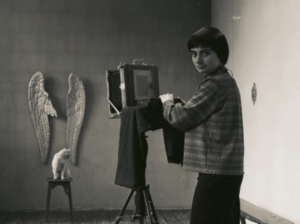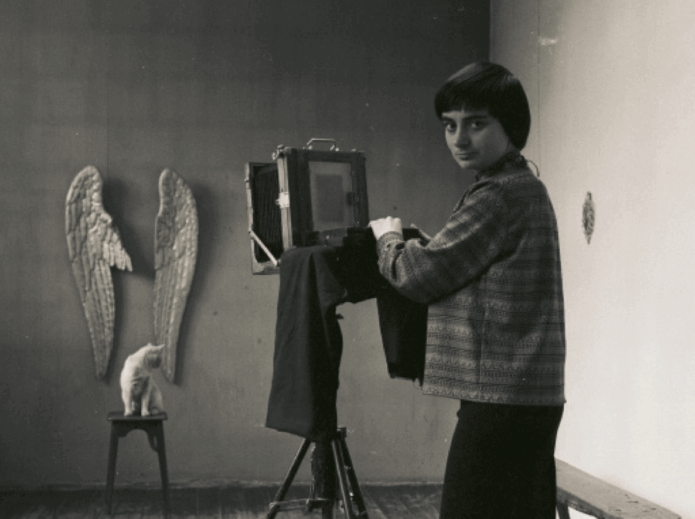Zowel in Amsterdam als in Parijs is dit voorjaar aandacht voor het werk van Agnès Varda (1928-2019). Het International Documentary Film Festival Amsterdam (IDFA) vertoont een reeks van haar documentaires, terwijl het Musée Carnavalet in Parijs een tentoonstelling wijdt aan haar fotowerk. Waar de documentaires uiteenlopende onderwerpen behandelen, staat in haar foto’s het alledaagse Parijs centraal.
Go to the English version of this article.
Aandacht voor documentaires
Tot eind mei vertoont het International Documentary Film Festival Amsterdam (IDFA) een reeks documentaires van Agnès Varda. De Franse filmmaker en kunstenaar maakte sociaal bewogen werk, veelal balancerend tussen fictie en documentaire.
Een van de documentaires is Daguerréotypes (1975), te zien op 21 mei 2025. Daarin portretteert Varda de winkeliers in haar eigen buurt. Het resultaat is een fascinerend tijdsdocument van een inmiddels vrijwel verdwenen groep middenstanders. (De originele versie staat ook op YouTube; je kunt ondertiteling aanzetten, al is die niet altijd even nauwkeurig.)
Ongepolijst Parijs
Fragmenten uit Daguerréotypes zijn ook opgenomen in de tentoonstelling Le Paris d’Agnès Varda, de-ci, de-là, te zien tot en met 24 augustus 2025 in het Musée Carnavalet in Parijs. De expositie richt zich op haar minder bekende werk: fotografie.
Bijzondere aandacht is er voor de binnenplaats aan de rue Daguerre in Montparnasse, waar Varda woonde en werkte van 1951 tot haar dood in 2019. De tentoonstelling laat zien hoe belangrijk Parijs was in haar oeuvre. Als expositiebezoeker krijg je geen geromantiseerd beeld van de stad voorgeschoteld, maar het ongepolijste Parijs.
Montparnasse
Varda werd geboren in Brussel. Tijdens de oorlog woonde ze in het Zuid-Franse Sète, van waaruit ze als tiener Parijs ontdekte. Na haar studie aan de École du Louvre besloot ze fotograaf te worden. Begin jaren 50 trok ze met haar toenmalige partner in twee vervallen winkelpanden met een binnenplaats in Montparnasse. Daar richtte ze een fotostudio in, fotografeerde buren, kunstenaars en jonge toneelspelers, organiseerde tentoonstellingen en draaide scènes voor haar eerste films.
Rue Mouffetard
De expositie bevat ook filmfragmenten, waaronder niet eerder vertoond materiaal. Ze laten zien hoe Varda door de stad dwaalt en haar favoriete thema’s onderzoekt. Ze had oog voor gewone mensen, met een bijzondere interesse voor vrouwen en buitenstaanders. Zo fotografeerde ze in 1957 mensen op de markt in de rue Mouffetard, toen een zeer arme wijk. Een jaar later zou ze er een film draaien.
Icoon
In de 21e eeuw groeide Varda uit tot een icoon in de kunstwereld. Met haar feministische en ecologische thema’s liep ze ver vooruit op haar tijd. In haar latere werk verscheen ze steeds vaker zelf in beeld. In haar vertrouwde binnenplaats aan de rue Daguerre filmde ze gesprekken met onder anderen Jane Birkin. Die plek bleef tot het einde een belangrijk decor in haar werk.
Musee Carnavalet, 23 rue Madame de Sévigné, 75003 Parijs.
© Tekst en foto’s: Monsieur Plusfours 2025
MELD JE AAN VOOR ONZE GRATIS NIEUWSBRIEF Schrijf je in

Agnès Varda, selfportrait in her studio rue Daguerre, Paris 14e, 1956 © Succession Agnès Varda
City of Stories: Paris Through the Eyes of Agnès Varda
This spring, both Amsterdam and Paris are paying tribute to the work of Agnès Varda (1928–2019). The International Documentary Film Festival Amsterdam (IDFA) is screening a selection of her documentaries, while the Musée Carnavalet in Paris is hosting an exhibition of her photography. While her documentaries span a wide range of subjects, her photographs focus on everyday life in Paris.
Spotlight on Documentaries
Until the end of May, IDFA is showcasing a series of documentaries by Agnès Varda. The French filmmaker and artist created socially engaged work that often balanced fiction and documentary.
One of the featured films is Daguerréotypes (1975), screening on May 21, 2025. In it, Varda portrays shopkeepers in her own neighborhood. The result is a fascinating time capsule of a now nearly vanished group of small business owners. (The original version is also available on YouTube; subtitles can be enabled, though they are not always entirely accurate.)
Unvarnished Paris
Excerpts from Daguerréotypes are also featured in the exhibition Le Paris d’Agnès Varda, de-ci, de-là, on view through August 24, 2025, at the Musée Carnavalet in Paris. The exhibition highlights her lesser-known work: photography.
Special attention is given to the courtyard on Rue Daguerre in Montparnasse, where Varda lived and worked from 1951 until her death in 2019. The exhibition reveals just how central Paris was to her body of work. Visitors won’t find a romanticized view of the city here, but rather an unfiltered, raw Paris.
Montparnasse
Varda was born in Brussels. During World War II, she lived in Sète in southern France, from where she first explored Paris as a teenager. After studying at the École du Louvre, she decided to become a photographer. In the early 1950s, she and her partner moved into two derelict shopfronts with a courtyard in Montparnasse. There, she set up a photo studio, photographed neighbors, artists, and young actors, organized exhibitions, and shot scenes for her early films.
Rue Mouffetard
The exhibition also includes film clips, some never shown before. These show Varda wandering through the city, exploring her favorite themes. She had a sharp eye for ordinary people, with a particular interest in women and outsiders. In 1957, she photographed people at the market on Rue Mouffetard, then a very poor neighborhood. A year later, she would film there.
Icon
In the 21st century, Varda became an icon in the art world. Her feminist and ecological themes were far ahead of their time. In her later work, she began appearing more frequently in front of the camera. On her familiar Rue Daguerre courtyard, she filmed conversations with, among others, Jane Birkin. That location remained a central backdrop in her work until the very end.
Musee Carnavalet, 23 rue Madame de Sévigné, 75003 Paris.
© Text and photo’s: Monsieur Plusfours 2025
